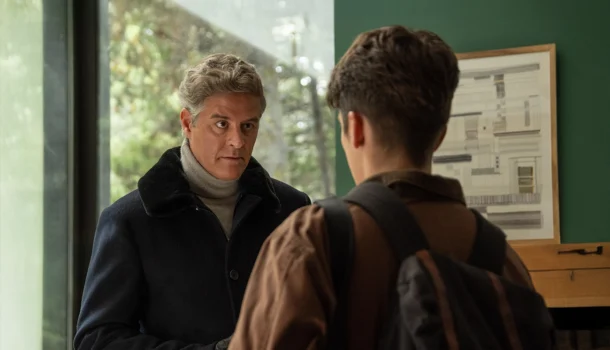In a social landscape where hate speech has ceased to be an aberration and become a habit, and where the suffering of others is consumed with the same indifference used to scroll through a news feed, there’s little room left for any genuine notion of empathy. When gestures once charged with tenderness turn into tools of domination, and childhood ceases to be a promise to become a factory of trauma, what remains of the humanity that once aspired to be civilized? The succession of domestic tyrannies, shaped in the womb of pain, reshapes the cycle of violence into something that not only repeats but refines itself, corroding the collective soul until only emptiness remains as legacy.
“Caught” operates within this thorny terrain with unsettling precision. Though its surface structure suggests a conventional thriller — a sexual predator lurking in a remote community — what gradually unfolds is a mosaic of emotional deformities and moral fractures. Based on the novel by Harlan Coben, Miguel Cohan and Hernán Goldfrid refuse to be satisfied with the plot’s surface. By relocating the narrative from New Jersey to the hauntingly beautiful landscapes of Patagonia, they expand the story’s symbolic reach. There is no breath, no sanctuary — not even in the glacial vistas of Bariloche — when the true violence is the one that germinates inside the home, silently, until it matures into monstrosity.
At the center of this narrative maze is Ema Garay, a crime reporter whose pursuit of justice teeters on the brink of obsession. A widow, mother, professional, and survivor, she navigates the ruins of her life with the calculated coldness of someone who knows that too much sensitivity paralyzes. Her conviction that she has found the perpetrator — Leo Mercer, a social worker who seems crafted from a manual of good intentions — leads her to construct a trap that blends psychological engineering, media manipulation, and an online game. There is no naivety in this plan: what Ema seeks is more than a headline; she wants to rewrite the rules of pain.
It’s in this psychological duel between Ema and Leo that the series reaches its most disturbing tension. Leo, portrayed by Alberto Ammann with just the right balance of vulnerability and latent menace, never offers easy answers. His character oscillates between savior and aggressor, between wrongful accusation and the stereotype that haunts every unresolved abuse case. The viewer is forced to revisit an uneasy question: how often is the innocent condemned out of convenience? How often is the guilty absolved out of cowardice? In this minefield of moral ambiguity, every choice seems wrong — or worse, irrelevant, in the face of a justice system that long ago ceased to repair anything.
The directors make a conscious decision never to offer catharsis. Each episode avoids the safety of moral instruction and instead delves into nuance: no victim is spotless, and no villain is stripped of humanity. The icy landscapes — at times sublime, at times menacing — act as emotional mirrors for the characters, especially Ema, whose complexity never settles into a single dimension. Her coldness hides an irreparable fracture, and her courage is merely the public face of a guilt too ancient to name.
More than a well-crafted suspense, what emerges is a dark portrayal of the persistence of trauma and how it finds shelter in everyday structures. Here, the past is not memory: it is an active, corrosive presence that contaminates every gesture and distorts every relationship. Sexual violence, in all its silent brutality, is not treated as an exception but as a symptom. There is no aesthetic exaggeration, no easy emotional appeal — only a deliberate dryness, as if knowing that some pain allows no anesthesia, only the raw confrontation with what has been ignored for far too long.
“Caught” offers no answers and seems uninterested in providing comfort. Its strength lies precisely in the unease that lingers after the final episode, without the relief of resolution or the illusion of justice. This is a narrative built to disturb, not to entertain — and in that discomfort lies its greatest merit. When entertainment dares to stare directly into horror, without filters or mercy, it ceases to be an escape and becomes a mirror — one that, though cracked, insists on reflecting the most unacceptable parts of ourselves.
Series: Caught
Creator: Miguel Cohan and Hernán Goldfrid
Year: 2025
Genres: Drama/Mystery/Crime
Rating: 8/10

